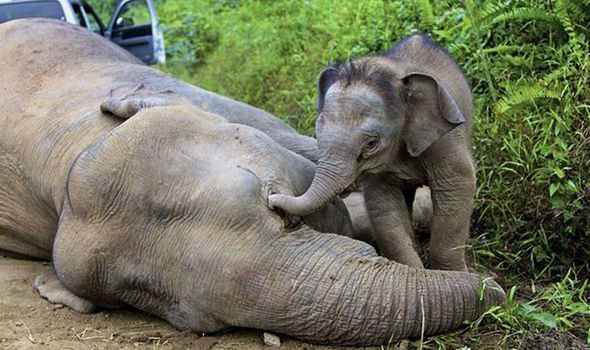The Fight for Elephants

February 7, 2021
In the last century, the elephant population fell by 12 million. Today, an estimated number of only 415,000 elephants are left in Africa, and about 40,000 to 50,000 elephants reside in Asia. While elephants are regarded as vulnerable and endangered, some of their bloodlines are still being poached towards extinction. If immediate action is not taken, elephants could be extinct as soon as 2040.
Elephants are some of the world’s biggest animals, the largest being the African elephant male at six tons. Smaller Asian elephants can weigh up to five tons. As very social animals, elephants live in herds and need lots of space with substantial amounts of food and water to provide for them. Unfortunately, their habitats are shrinking. African elephant habitats have declined by over 50% since 1979, and Asian elephants have been restricted to just 15% of their original range.
The African elephant population has depreciated 70% in the last 40 years, mainly because of the illegal ivory trade, the biggest driver of elephant poaching. Every year, 20,000 elephants are killed to feed this trade—that’s about one death every 26 minutes. For thousands of years, elephants have been killed for their prized ivory tusks. In about 1323 B.C., Egyptian pharaoh Tutankhamun was laid to rest on a headrest of ivory. In Syria, the elephant population was wiped out for their ivory by 500 B.C. In the present day, ivory can be used to manufacture piano and organ keys, billiard balls, ornaments, eating utensils, and decorations, as it can be painted or bleached and provides excellent material for carving. Prized for its close-grained texture, durability, neutral color, and smoothness, ivory can also be used to manufacture electrical appliances.
In 1989, the Convention on International Trade in Endangered Species (CITES) banned the international trade in ivory due to the sharp decline in the African elephant population. This led to a recovery in elephant numbers until 2008, when there was an infiltration of the ivory trade by criminal gangs. Demand for ivory rose in Asia, leading to high levels of corruption and increased illegal poaching levels; despite the ban on the ivory trade, illegal poaching has exploded. In 2015 alone, around 20,000 African elephants were killed for their tusks, which was more than the number of elephants that were born! Some believe that large amounts of ivory were bought and stored in secret warehouses by investors who needed someplace to hide money from the global downturn. Criminal gangs most likely bribed officials to ship vast quantities of ivory through ports to illicit factories in primarily China, Vietnam, Malaysia, and Thailand.
Some people see the killing of elephants as a battle for land, not ivory, as in recent years, human-wildlife conflicts have risen. As the human population grows, so does the demand for space, and poaching removes elephants from land while also leaving it open for development. By 2050, 63% of the remaining elephant rangelands will be compromised by human encroachment.
It’s not just a battle for land, though. In Asia, elephants can destroy the annual crop of many small farmers in just one evening. In India, panicked or enraged elephants can kill more than 400 people each year, causing wildlife authorities to hunt down and kill these elephants. In Indonesia, dozens of elephants are poisoned by palm oil growers each year.
Regardless, elephants play a crucial role in ecosystems by helping to maintain healthy habitats for other species by dispersing seeds. While trees produce millions of seeds and only one seed needs to make it to the ground to grow successfully, researchers found that trees planted through elephant-dispersal have a better chance at survival. Additionally, elephants also contribute towards tourism and community incomes in many areas. Unfortunately, though, governments of nations where elephants live often lack sufficient resources to protect and monitor elephant herds since they reside in remote and inaccessible habitats. To help protect elephants, organizations worldwide are taking steps to stop illegal poaching and ivory trade and protect elephant habitats. The World Wildlife Fund (WWF) is working to conserve elephants in Africa and Asia through specific programs made to improve elephant protection, mitigate human and elephant conflicts, and reduce poaching and illegal ivory trade. Bring the Elephant Home, an organization in the Netherlands, is working to ensure the survival of African and Asian elephants through research and conservation so that humans and elephants can coexist and benefit from each other. Here, in the United States, Born Free USA is working tirelessly to investigate illegal poaching, put an end to elephant captivity, and educate the public on the issue.
If urgent action isn’t taken, elephants will go extinct. Soon. Over the last three generations, Asian elephant populations have dropped by at least 50%, and are still declining today. From about 26 million elephants on the planet in the 19th century to just a tiny fraction of that number today, the public must understand the severity of the issue and the actions that must be taken to help preserve and increase the elephant population.
Barbara • Apr 10, 2024 at 1:41 PM
People who are illegally poaching animals for some sort of gain, are disgusting. When I found out that the CEO of Jimmy John’s does illegal poaching, I stopped eating there. I just wish there was an actual way to help elephants.